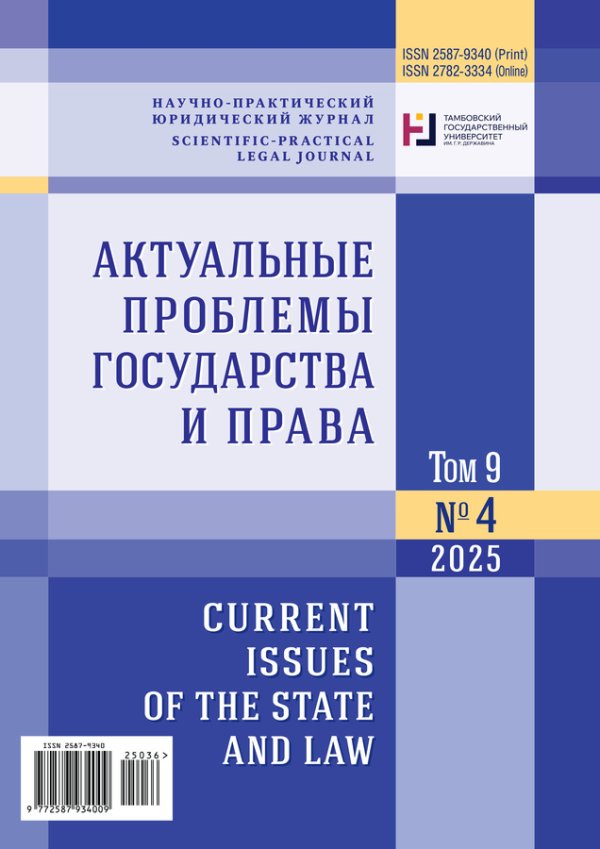Использование мягкого права в сфере противодействия коррупции
- Авторы: КУЗНЕЦОВА О.А.1
-
Учреждения:
- ФГАОУ ВО «Российский государственный университет дружбы народов им. Патриса Лумумбы»
- Выпуск: Том 7, № 4 (2023)
- Страницы: 504-514
- Раздел: Общая теория и история права и государства
- URL: https://bakhtiniada.ru/2587-9340/article/view/303622
- ID: 303622
Цитировать
Полный текст
Аннотация
Проанализированы иные, помимо уголовно-правовых, способы борьбы с транснациональной коррупцией. К таким способам можно отнести создание неформальных сетей взаимодействия между национальными агентствами по борьбе с коррупцией; участие в борьбе с коррупцией негосударственных игроков, таких как Всемирный банк, Международная торговая палата, и некоммерческих организаций, таких как Трансперенси Интернэшнл; разработка крупными международными банками и агентствами развития режимов расследования и наказания компаний, которые вовлечены в коррупционную деятельность в рамках финансируемых ими проектов; внедрение Модельных кодексов корпоративной этики и функционирование комплаенс-механизмов в корпорациях. Отмечено, что указанные способы особенно выгодны на международном уровне, где отсутствует некий наднациональный суверен, и эффективность межгосударственного сотрудничества остается ограниченной. Сделан вывод о том, что создание новых механизмов, в том числе механизмов «мягкого права», позволяют выработать более разносторонние и эффективные подходы к борьбе с коррупцией. В частности, путем развития механизмов мягкого права, таких как диалог и сохранение репутации, а также создания сетей регулирования, негосударственные организации получают возможность контролировать деятельность корпораций. Отдельно подчеркнуто, что такие механизмы не являются панацеей, однако представляют собой ценный регулятивный ресурс, каковым и должны признаваться мировым сообществом.
Об авторах
Ольга Алексеевна КУЗНЕЦОВА
ФГАОУ ВО «Российский государственный университет дружбы народов им. Патриса Лумумбы»
Автор, ответственный за переписку.
Email: o715575@mail.ru
ORCID iD: 0000-0003-1066-3783
кандидат юридических наук, доцент, заведующий кафедрой уголовного права, уголовного процесса и криминалистики, Юридический институт
Россия, 117198, Российская Федерация, г. Москва, ул. Миклухо-Маклая, 6Список литературы
- Hellman J.S., Jones G., Kaufmann D. (2002). Far from home: do foreign investors import higher standards of governance in transition economies? New York, SSRN Publ., 29 p. https://dx.doi.org/10.2139/ssrn.386900
- Knack S. (2000). Aid Dependence and the Quality of Governance: A Cross-Country Empirical Analysis. Washington, DC, World Bank Publ., no. 2396, 44 p.
- Evenett S.J., Hoekman B.M. (2005). International Cooperation and the Reform of Public Procurement Policies. Washington, DC, World Bank Publ., no. 3720, 39 p. https://doi.org/10.1596/1813-9450-3720
- Picciotto S. (1997). Networks in international economic integration: fragmented states and the dilemmas of neo-liberalism. Northwestern Journal of International Law and Business, vol. 17, issue 1, pp. 1014-1064.
- Slaughter A.-M. (2004). A New World Order. Princeton, Princeton University Press, 376 p.
- Thorsten B., Wolgang R.H. Witte J.M. (2004). Multisectoral Networks in Global Governance: Towards a Pluralistic System of Accountability. Government and Opposition, vol. 39, issue 2, pp. 191-210. https://doi.org/10.1111/j.1477-7053.2004.00120.x
- Ware G.T., Noone G.P. (2005). The Anatomy of Transnational Corruption. International Affairs Review, vol. 14, no. 2, pp. 29-51.
- Spender P. (2002). Christine Parker, the open corporation: effective self-regulation and democracy. University of New South Wales Law Journal, vol. 25, no. 2, pp. 611-615.
- Delaney P. (2005). Transnational Corruption: regulation across border. Asia Pacific School of Economics and Government at the Australian National University. Discussion Papers. Canberra, 37 p.
- Zagaris B. (2015). Transnational Corruption. In: International White Collar Crime. Cambridge, Cambridge University Press, pp. 105-167. https://doi.org/10.1017/CBO9781316258330.005
- Arnone M., Borlini L. (2014). Corruption: Economic Analysis and International Law. Cheltenham, Edward Elgar Publ., 2014. 362 p. http://dx.doi.org/10.4337/9781781006139
- Low L., Lamoree S., London J. (2015). The “Demand Side” of transnational bribery and corruption: why leveling the playing field on the supply side isn’t enough. Fordham Law Review, vol. 84, issue 2, pp. 563-599.
- Kevin K. (2009). Does the Globalization of Anti-corruption Law Help Developing Countries? New York University Law and Economics Working Papers. New York, no. 09-52, 35 p.
Дополнительные файлы










